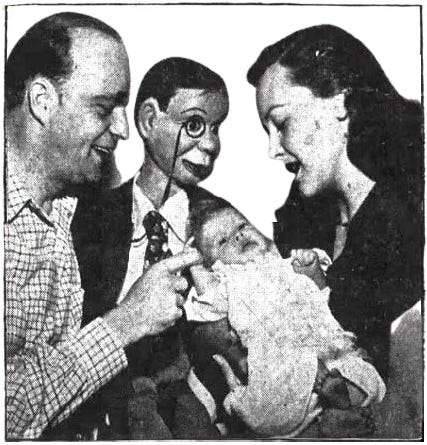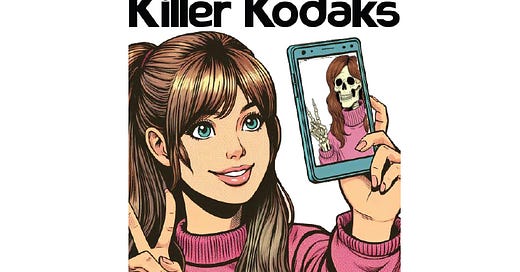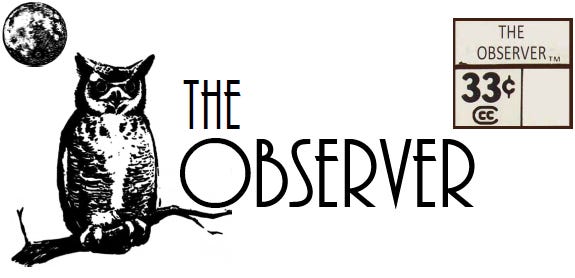Killer Kodaks and Soul-Snatching Shutterbugs (Part 1 of 3)
In 1965, future "Murphy Brown" star Candice Bergen was afraid for her soul...
In 1965, future Murphy Brown star Candice Bergen was afraid for her soul. The actress had just cut her teeth in the film The Group, and though she was hesitant to pursue a Hollywood career, additional movie offers were pouring in.
Despite early success, Bergen struggled with the prospect of living life in front of the viewfinder: “I did worry about my salvation, strongly suspecting that there was no small truth in the ancient belief that the camera steals the soul.”1
As an aspiring model, budding celebrity, and daughter of a famous comedian, Bergen was no stranger to having her picture taken. When she was six-years- old, the Saturday Evening Post ran photos of her dressed in black while attending her pet turtle’s funeral.
As the starlet considered her future on the big screen, she questioned whether the lure of the lens might amount to a siren’s song: “The forces pulling me into closer and closer proximity with cameras were clearly stronger than any opposing ones of my own, and I still swore I was not going to let them get me. They were not going to steal my soul.”2

Bergen’s instinct to protect her likeness is rooted in ancient taboos that condemn the creation of graven images. Traces of this phobia still exist, manifesting in cultural superstitions and urban legends about cursed cameras bringing misfortune to all who encounter them.
What inspires our wariness toward these man-made “vision machines”3 and the pictures they capture?
Photography began in earnest almost 200 years ago with the invention of the daguerreotype (an early process that used silver-coated plates to create images). The public was suspicious from the start. The ability to capture a scene and reproduce it at-will was magician’s work—and to an under-informed layman, photographers appeared to practice “the real black art of true magic.”4 Many suspected that there was more involved in the process than a simple interplay between light and chemicals. Pictures were “supernatural etchings”5 or “magical emanations”6 generated by the power of the sun. In fact, some believed they were more than a facsimile—they were actual “pieces of the world transferred by light to a plate.”7
When photography first hit the German scene, one newspaper denounced it as a textbook example of blasphemy: “Man is created in the image of God and God’s image cannot be captured by any human machine.”8 Mechanically replicating Heaven’s craftsmanship was an act of hubris on par with the construction of the Tower of Babel. Segments of the population worried that meddling with these forces would invite a similar fate upon society. An 1853 editorial by a recent photographee captured the nervous uncertainty that the operation inspired: “There is something about the daguerreotype that bespeaks a hand not of this world. To punish us for penetrating her mysteries, Nature touches us with the shadowy hand of death.”9
Like alchemists turning base metals into gold, photographers breathed life into a blank piece of paper—a transformation some found unnerving. The entire procedure “smelled devilishly like a spell and reeked of heresy.”10 Early camera-cranker Abraham Bogardus documented people’s reactions to the new technology, describing how photogs were accused of using “hocus-pocus”11 to conjure up their images. Some enterprising picture-takers deliberately emphasized this mystical association. As historian Robert Taft put it—“they imposed themselves as magicians”12 to elevate their stature in the minds of potential customers. By mystifying an already enigmatic process, early photographers helped feed many of the public’s apprehensions.
Soul Snatchers
If you dread being photographed, you’re not alone. The First Nations people of the Canadian Plains called cameras “face pullers.”13 According to archivist Brock Silversides, they believed that something was lost during an exchange with the contraption—“as if a part of them (spirit) was being taken away, thus weakening them, when a photograph was produced.”14
While the nickname’s subtleties were likely lost in translation, the suggestion that a camera can physically grab its subject and pull it into the lens is a graphic way to illustrate common anxieties about technology’s impact on individualism and personal autonomy.
Similar concerns about cameras with supernatural abilities were present throughout the Asia-Pacific region. In the intro to his 1870 travelogue, Scottish photojournalist John Thomson revealed that some Chinese regarded him as “a dangerous geomancer.”15
His camera became “a dark mysterious instrument” that granted him the power to “pierce [their] very souls.” Anyone unfortunate enough to get caught on film was marked for certain death.
The Ainu of northern Japan shared this aperture-aversion. According to an 1894 report in the Journal of American Folklore, the Ainu were put off by recreations of their image and warned of the practice’s adverse effects:
“To produce a person’s form on paper was considered to be like drawing the soul out of him and placing it in an unnatural position, and the man himself was henceforth supposed to be gradually shadowing off into mere physical form without material substance. In short, the Ainu appeared to think that by having his photograph taken a person was thereby being transformed into a ghost before his time.”16
Reservations about photo technology were also common in the United States—especially in the years directly following its introduction. This was partly a response to the period’s high infant mortality rate. Some superstitious parents feared that creating a “representation” of the child might hasten their demise and “destroy [their] existence.”17 As a result, many families were reluctant to let their young ones sit for a session in front of the camera.
Science and Séance
Traces of photo-phobia lingered into the 20th century. In the 1930s, German philosopher Walter Benjamin suggested that an object’s “aura” (the intangible qualities that make it distinct and authentic; “its presence in time and space”18) is diminished anytime it’s subjected to mechanical reproduction. Duplicating an object removes a layer of uniqueness and detaches it from its original context.
This perspective supports the strange theory reportedly held by famous French novelist Honoré de Balzac (1799-1850) who warned that photography could strip the “spectral material”19 from a subject’s body. He theorized that “each time a photograph was taken, an actual layer of skin was destroyed.”20 Because man couldn’t create something out of nothing, the likeness captured by a photograph had to derive from pre-existing matter—a substance extracted from the object and impressed upon the film. Balzac worried that “repeated exposures” to a camera’s lens would deplete these “ghostly layers” or “specters” making up our corporeal bodies.21
Put simply—posing for too many pictures might cause a person to slowly fade away.
Part 2 - Coming Soon!


Bergen, Candace. Knock Wood. Linden Press, 1984, p.152.
Ibid, 152.
Virilio, Paul. The Vision Machine. Indiana University Press, 1994.
Willis, N.P. “New Discovery in the Fine Arts,” The New Yorker. April 20, 1839.
Virilio, Vision Machine, 20.
Trachtenberg, Alan. Reading American Photographs. Hill and Wang, 1989, p. 14.
Ibid, 14.
Leipzig City Advertiser, quoted in Benjamin, Walter. “A Short History of Photography,” 1931.
“A Few Photographs.” The Knickerbocker, August 1853, p. 140.
Nadar, Félix. When I Was a Photographer. The MIT Press, 2015, p. 3.
Trachtenberg, Reading American Photographs, 13.
Taft, Robert. Photography and the American Scene. Dover Publications, 1964, p. 48.
Silversides, Brock. The Face Pullers. Fifth House Ltd, 1994, p. 6.
Ibid, 7.
Thomson, John. Illustrations of China and Its People. Marston, Low, and Searle, 1873, vol. 1, Introduction.
Batchelor, John. “Items of Ainu Folk-lore,” Journal of American Folklore, January-March 1894, p. 15-44.
West, Nancy M. “Camera Fiends: Early Photography, Death, and the Supernatural.” The Centennial Review, vol. 40, no. 1, 1996, p. 171.
Benjamin, Walter. “The Work of Art in the Age of Mechanical Reproduction,” 1935.
Nadar, When I Was a Photographer, 4.
West, Nancy M. “Camera Fiends.” p. 177.
Cadava, Eduardo. “Introduction: Nadar’s Photographopolis,” as cited in Nadar, Félix, When I Was a Photographer. The MIT Press, 2015, p. XVII.















The paranormal aspect of photography is incredibly thought-provoking, and this article is an excellent introduction to this fertile field of study. And take Mark Macy's research, which is described in-depth in his book, published in 2006, Spirit Faces: Truth about the Afterlife. Witness today also the "photobombing" captures of mysterious and unaccounted for images of faces, disembodied hands shadow people or what is believed to be ghosts appearing in the backgrounds of many a selfie. (YouTube channel: Slapped Ham) Looking forward to part two. Meanwhile, "Smile, you're on Candid Camera!"